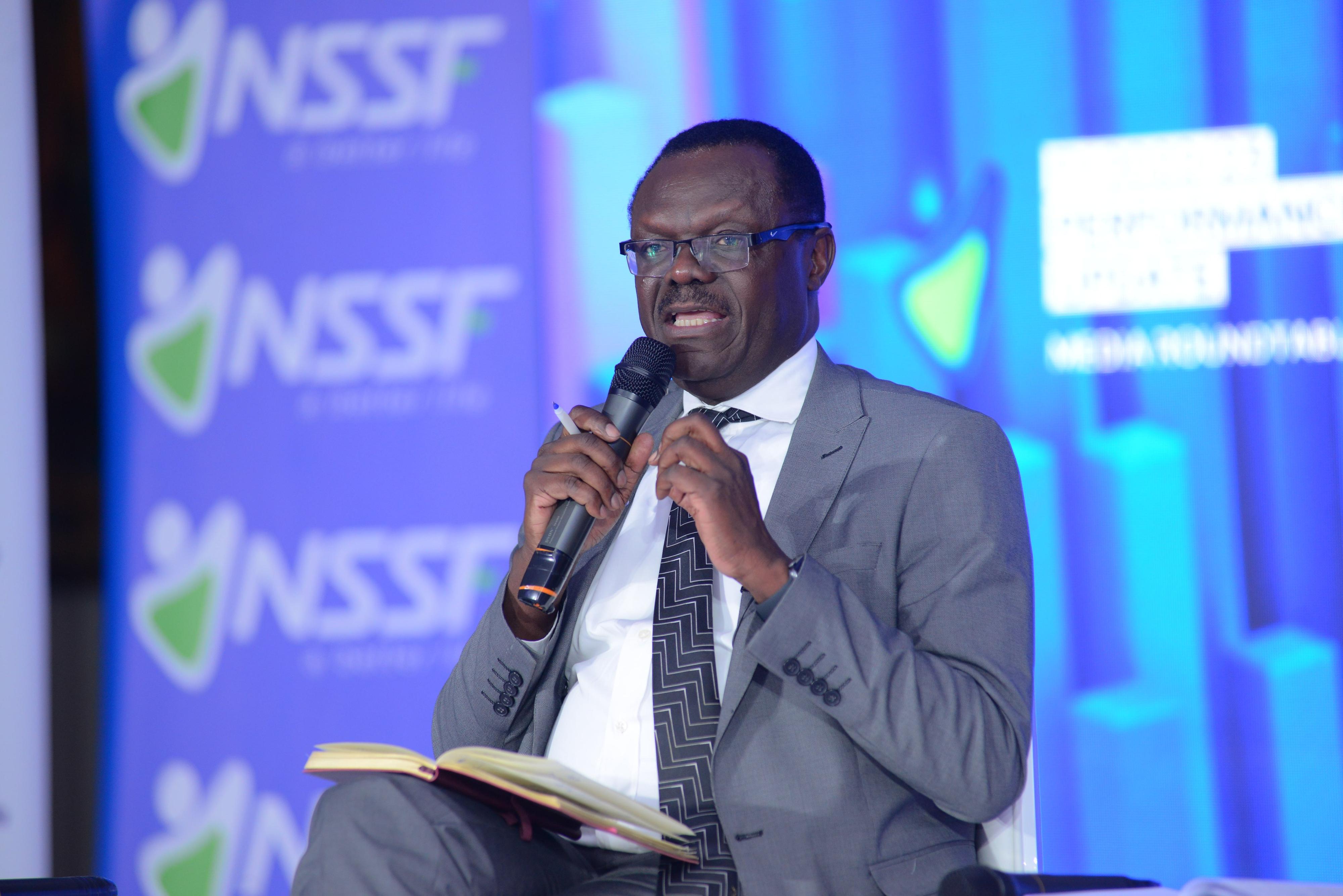NSSF grows its assets by Shs1.6t in 5 months

NSSF managing director, Patrick Ayota. PHOTO | COURTESY
What you need to know:
- Growth. NSSF’s total realised income has increased by 15 percent, from Shs1.9 trillion in the FY 2021/22 to Shs2.2 trillion in the FY 2022/23.
The National Social Security Fund has (NSSF) increased its assets under management by Shs1.6 trillion between February and July 2024, a figure that has put its overall assets to Shs21.6 trillion.
These new figures, as confirmed by its executives, show that the provident Fund’s assets have grown significantly beyond the Shs20 trillion target set by its 10-year strategic plan that was envisioned for June 2025. This target was reached at the backend of January 2024, meaning that, over the 151 days leading up to July 2024, the Fund’s assets have grown by at least Shs10.60 billion per day.
The state-controlled Fund’s managing director Patrick Ayota attributed this to the consistent growth in both contributions from members and income from the Fund’s investments which are distributed in real estate, equities and government paper.
“The preliminary analysis shows that performance on the key indicators will surpass our annual targets. We have commenced our annual audit. We will update NSSF members at the end of that exercise,” he said.
The Fund introduced the 2015–2025 strategic plan in 2015, with primary strategic goals of increasing the assets it manages (Assets Under Management) to Shs20 trillion by 2025 and streamlining business procedures so that benefits can be disbursed to eligible members in a single day.
Tonic for savers
As of July, NSSF’s fixed income portfolio stands at 79.1 percent of total assets. Elsewhere, the equity and real estate portfolios stand at 13.8 percent and 7.1 percent respectively. Assets Under Management (AUM) represent the total market value of the investments that a fund manages on behalf of its contributors. It is a critical measure because it indicates the size and scale of a fund’s operations, and it can impact its ability to generate returns, manage risk, and attract new contributors due to the impression of the prudent and profitable investment decisions that it’s making.
NSSF’s members amass 2.2 million people to date and those are employees whose employers remit contributions to the Fund every month.
Last year, Peter Kimbowa, the Fund’s chairman of the board of directors, reported that contributions from members had climbed from Shs1.49 trillion in the fiscal year (FY) 2021/22 to Shs1.72 trillion in the FY 2022/23, a 15.4 percent increase.
The Fund has not yet disclosed updated performance data for the previous year, which ends in June 2024 according to its books since it’s a government entity that files per financial year. Mr Ayota, however, stated on Thursday that this will happen shortly after an independent audit of its financial statements is finished.
With a surge in the assets it manages, many financial analysts believe the Fund may be able to offer better benefits, such as higher pensions or returns to contributors. This can also impact its fee structure. Larger funds usually have lower management fees due to economies of scale.
Challenges
The only challenges associated with larger assets under management is that as the Fund grows, managing the investments becomes more complex and may require additional resources and expertise. Larger funds often attract more regulatory scrutiny, requiring stricter compliance and reporting measures. And NSSF knows this.
Early this year, details emerged that NSSF had a staggering deficit on its balance sheet, with accumulated member funds exceeding total assets by Shs508 billion due to the allocation of interest to members’ accounts that exceeded amounts available for interest allocation. This surfaced in a government audit which showed that NSSF incurred an instant deficit of Shs794 billion due to the interest allocation, a case that raised concerns regarding the Fund’s solvency and how quickly it could address that.
When the accumulated members’ funds exceed a fund’s total assets, it suggests that the fund may not have enough assets to cover its liabilities to members at that given time. In the worst-case situation—which did not exist in this case—the fund might be forced into insolvency proceedings, which would cause losses for its members. This deficit issue even attracted the pension regulator’s attention at the time (February 2024).
The Uganda Retirement Benefits Regulatory Authority (URBRA), told this reporter following a series of queries at the time that should this issue fail to be resolved as soon as possible, it would lead to a “market distortion.”
“We got to know about it and we took action. We are already monitoring how the whole process goes in the strongest terms possible,” Martin Nsubuga, the chief executive officer of URBRA, said without giving more details at the time.
This crisis, according to chartered financial analyst Mr Allan Lwetaba, may have arisen from the Fund’s inability to recover significant profits from its investment vehicles. This despite having a duty to offer competitive market interest rates that are also two percent higher than inflation.
NSSF’s total realised income had increased by 15 percent, from Shs1.9 trillion in the FY 2021/22 to Shs2.2 trillion in the FY 2022/23.
Beyond the numbers
The increase in income allowed the Fund to increase its paid benefits to savers by one percent, from Shs1.189 trillion to Shs1.199 trillion, during the period. The Fund calculated an interest rate for the period totalling Shs1.6 trillion, or 10 percent for each saver. This indicates that it had to allocate its member’s accounts at least Shs2.799 trillion that included member benefits and interest for FY 2022/23. And on top of that, it had to leave some money untouched for mid-term access and the rest for any saver who would have wanted to exit the fund.
A look at the Fund’s 2023 annual report showed that it recorded the most income from interest (a 14 percent increase to Shs2 trillion) driven by increased investments in government bonds in Uganda and a Euro bond in Kenya. It also recorded a 25 percent increase in dividend income to Shs145.1 billion, but saw a slight decline in real estate income of 0.2 percent to Shs11.95 billion period. This, Mr Lwetaba said, might have been less of the Fund’s projections.
NSSF was reached on this matter at the time but couldn’t respond. That said; its 2023 annual report showed that it lost Shs1.05 trillion in the year ended June 30 2023 due to a mix of capital flight from the equity and bond markets and constrained cash-flows from cross-border equity investments, which many pension funds grappled with.
Previously, when pension funds registered lower-than-expected income, they used to leverage their reserves to raise money and distribute it to members as interest and benefits to active savers and those who were exiting within a given fiscal year. They were able to draw from these reserves to make up for deficits during times of crisis, which was helpful. However, about eight years ago, URBRA realised that this was creating a distortion in the pension market. This was because some savers could exit the funds when their money was still locked up in many entities’ reserves.
As a result, URBRA compelled them to set aside 10 percent of their reserves, and they were required to account for the remaining amount in their actual income and liability balances.
What next?
On Thursday, Mr Ayota said that “right now the Fund is fully funded. This means that all the claims of members and interest are fully covered by the assets of the Fund. And if for some reason we closed the Fund today, you know that within one year every member would be compensated. It would be immediate but the real estate and equities would take some time to liquidate.” The Fund’s next goal is to grow its AUM to Shs50 trillion by 2035.




